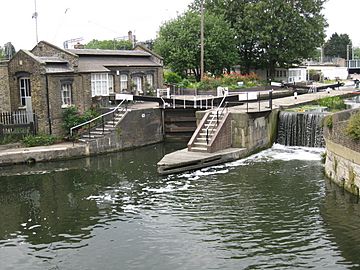St Pancras Lock facts for kids

St Pancras Lock, 2013
|
|
| Waterway | Regent's Canal |
|---|---|
| County | Camden Greater London |
| Maintained by | Canal & River Trust |
| First built | 1819 |
| Fall | 8 feet (2.4 m) |
| Distance to Limehouse Basin |
4.4 miles (7.1 km) |
| Distance to Paddington Basin |
3.5 miles (5.6 km) |
| Coordinates | 51°32′10″N 0°07′40″W / 51.536186°N 0.127877°W |
St Pancras Lock is a special kind of water elevator on the Regent's Canal in London. It helps boats move up or down between different water levels. This lock is located in the London Borough of Camden, and the St Pancras Basin is very close by.
Contents
History of St Pancras Lock
Building the Regent's Canal
The idea for the Regent's Canal was approved by law in 1812. The plan was to build a canal connecting Paddington to Limehouse. At first, the canal builders wanted to use special boat lifts. But these lifts had problems.
So, they decided to go back to using traditional locks. They chose to build two locks side-by-side at each location. This included St Pancras. This design helped save water. Water could be moved between the two locks instead of being completely emptied.
Opening the Canal
Building the canal faced some money troubles. Work stopped for a while but started again in 1817. St Pancras Lock was finished in 1819. The entire Regent's Canal officially opened on August 1, 1820.
How Locks Were Operated
In the canal's busiest times, lock-keepers worked all day and night. They made sure boats could pass through the locks smoothly.
Over time, fewer boats used the canal. This was partly because railways became popular. So, there were fewer lock-keepers. Locks were even locked with padlocks on weekends.
Today, most boats on the canal are for fun, not for carrying goods. Boat crews now operate the locks themselves. To prevent flooding from mistakes, one of the paired locks at St Pancras was changed in the 1980s. Its gates were removed, and a small dam (called a weir) was built.
Canal Over the Railway
Just below St Pancras Lock, the canal makes a sharp turn. It then crosses over the railway lines that lead to King's Cross using a special bridge called an aqueduct.
In 1939, during wartime, special "stop locks" were added at both ends of this aqueduct. These were put in place to protect the railway. If the aqueduct was damaged by bombs, the stop locks would limit water leakage onto the tracks.
Exploring the Area Around St Pancras Lock
Canal's Path and Basin
At St Pancras Lock, the canal flows from the north-west to the south-east. The water level drops as it goes through the lock. Before reaching the lock, the canal passes under the railway lines for St Pancras railway station.
Just past this bridge, you'll find the entrance to St Pancras Basin. This basin is to the west of the lock. It's a handy place for boats to turn around.
Lock Keeper's Cottage and Nature Park
Next to the south-west side of the lock is a historic building. It's a small, yellow-brick cottage with a slanted roof. This building was first designed in 1898 as a pumping station. It was built to pump water. But in 1926, it became the home for the lock keeper.
Along the south-western bank of the canal, as it continues south-east, is the Camley Street Natural Park. This park is a nature reserve. It opened in 1985 on land that used to be a coal drop for King's Cross station. It's a great place to see local wildlife.
The Jubilee Greenway
The path next to the canal is called the towpath. It's on the north-eastern side. This towpath is part of the Jubilee Greenway. The Jubilee Greenway is a network of paths that stretches about 37 miles (60 km). It was finished in 2012. Its purpose was to connect the places used for the 2012 Summer Olympics with parks, waterways, and other interesting spots.
Nearby Locks and Transport
The next lock upstream (to the west) is Kentish Town Lock No. 3. It's about 0.7 miles (1.1 km) away. The next lock downstream (to the east) is City Road Lock No. 5. It's about 1.0 mile (1.6 km) away.
If you want to visit St Pancras Lock by public transport, the closest London Underground station is King's Cross St Pancras. There are also main train stations nearby: King's Cross and St Pancras.

